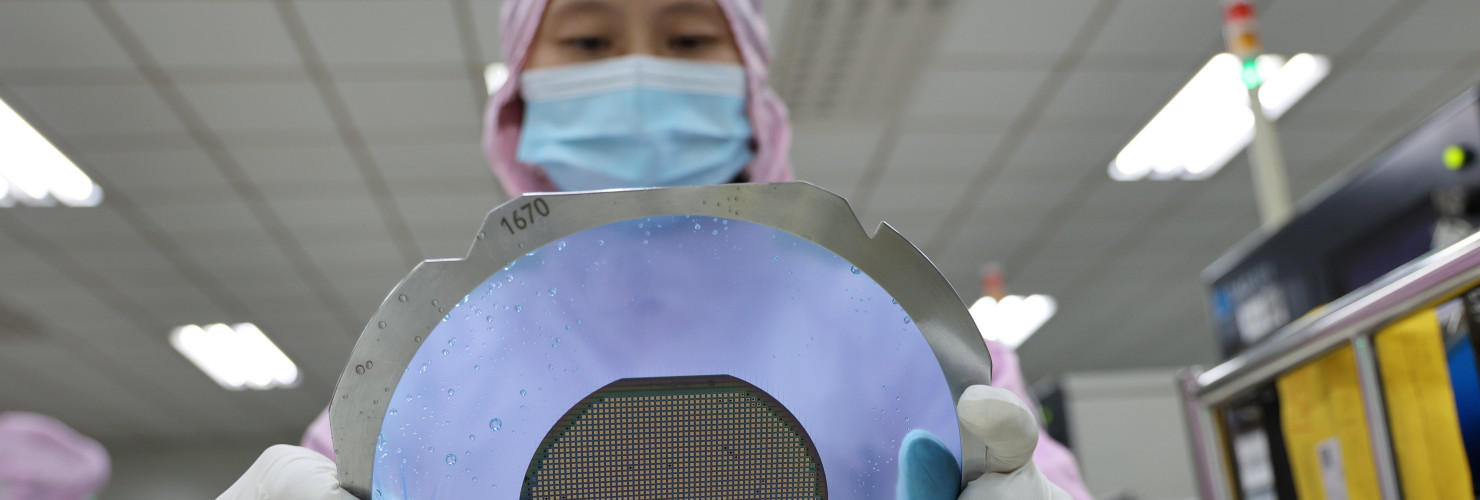

China’s long-term struggle to become integral in semiconductor supply chains
In semiconductors, China is much less able to exploit its dominant supply chain position than the US, says Antonia Hmaidi. But Beijing is building up the legal framework and market power to use dependencies in the semiconductor industry as a bargaining chip if it needs to. What can Europe do? This article is part of our series on China’s strategies to reduce vulnerabilities.
China has recently bolstered its 20-year effort to become self-sufficient in semiconductors, mainly in response to US export controls that limit access to semiconductor manufacturing equipment. Semiconductors are seen as a vital future technology, essential for green and digital technologies. They are also key for Artificial Intelligence, which is expected to be transformative for both civilian and military uses – and thus significant for national security.
Europe needs to find strategies to secure supply chains and prevent China from exploiting areas where it has a dominant position in the supply chain. Like its chip-related science and technology megaprojects, China’s Big Fund for integrated circuit development has poured investments into semiconductors. The EU, too, has identified advanced semiconductors as an area where risk assessments are needed and is looking keenly at its supply chain dependence on China. To counter rival moves, China has tried to build up its own supply chain edge in technology that its trading partners depend on for manufacturing. But in semiconductors, China is much less able to exploit these so-called chokepoints than the US.
China has built up chokepoints in and outside the semiconductor supply chain
China’s success in semiconductor self-sufficiency has been mixed. Manufacturers SMIC and YMTC, two large winners of Big Fund grants, have both taken on a lot of low-end production. National telecommunications champion Huawei, which the US has placed on its Entity List of trade-restricted companies, has managed with its chip design arm HiSilicon to create high-performance chips. In addition, a significant chunk of global testing and packaging (or back-end manufacturing) is happening in China. However, both SMIC and YMTC are still very dependent on Western equipment, especially for making more high-end semiconductors. Until September 2023, Huawei was unable to domestically manufacture a 5G smartphone on a high-performance 7nm-class process. Further progress is being hampered by new US export controls and entity listings.
China has built up chokepoints in certain chemicals and materials, both in and outside the semiconductor supply chain. It produces 64 percent of world silicon supply, almost 60 percent of world germanium supply, and 80 percent of gallium, key components in products like solar cells for countries to achieve green transition goals. China instituted export controls on gallium and germanium last year. But exploiting these dominances in the medium to long term will be harder because the materials are abundant and China does not have a technology lead. They are produced in China mainly due to a market-efficiency lead, and they are bolstered by subsidies, government support and low environmental regulation.
Semiconductor companies have said they could find other sources for gallium and germanium, if necessary. Many such materials are used in very small quantities for semiconductor manufacturing at high possible margins, meaning that producers could sustain a price increase. This is not the case for materials like tungsten in wind turbines, or certain materials for batteries. Using those materials to pressure Western producers is thus much more likely to be successful, but is unlikely to directly affect semiconductor companies.
With US export controls limiting Chinese high-end semiconductor progress, China has recently invested more in the less cutting-edge legacy semiconductors, especially at the 28nm node and above, where it already had a sizable market presence. These are used in consumer-grade products like cars. In theory, China could be self-sufficient in some of these older, cheaper semiconductors. But again, it does not have a technology lead. Countries can impose anti-subsidy duties on these products, which could prevent China from becoming as dominant in these semiconductors as in other supply chains.
China is also investing in semiconductors for specialized supply chains. One way the government is securing its economy is by encouraging companies to vertically integrate their supply chains within a company or a group of companies. BYD, China’s electric vehicle maker, for instance, designs its own chips. Huawei does the same but for different purposes – a general-purpose system on a chip (SoC) for their new phone, the Huawei Mate 60 Pro, and specialized chips for their 5G base stations, among others. These could eventually lead to bottlenecks, for instance in electric vehicles and power semiconductors, but China still does not have a technical lead.
China is working hard to reduce semiconductor dependencies
How can Europe manage this situation? In theory, it could substitute all of China’s inputs in the semiconductor supply chain, but this would be costly. And substituting everything at the same time would be almost impossible, especially if China were to restrict multiple materials simultaneously. However, China’s semiconductor dependencies make such a development unlikely in the short term, as the EU (und US) could counter by choking off more and more chemicals, chips, and semiconductor manufacturing equipment. With mutually assured destruction limiting China’s capacity to act, Europe has an opportunity to rework supply chains and prepare for different scenarios.
However, as China is working hard to reduce its dependencies, the window of opportunity for Europe to preempt this is shrinking. The risk assessment recommended by the EU is a good first step, but since this lies with member states, they are unlikely to take the needed long-term, systemic perspective on risks for the EU as a whole. A technology-centric approach also limits cross-technology and cross-supply chain risk evaluation. China could simultaneously restrict materials necessary for the semiconductor supply chain and materials necessary for other supply chains. While this could be painful in the short run, spreading the costs over a number of companies and industries could actually help Europe cut its dependencies more quickly and effectively.
Overall, China is building up both the legal framework and the market power to exploit dependencies in the semiconductor industry if it needs to. Success has been modest so far, as China has been unable to develop a technology lead. China’s first forays into restricting exports have also been limited, both in scope and in impact. If things develop the way Beijing wants them, the situation will shift to its advantage – and China is not treading water. The government has a systematic, long-term plan to beef up its weaknesses – reducing areas where China depends on others, while increasing foreign dependencies on China.
The EU has taken a first step in recommending a risk assessment for advanced semiconductors. However, any risk assessment should look not only into current dependencies, but also long-term trends, projections of the future, cross-industry and cross-country risks.

